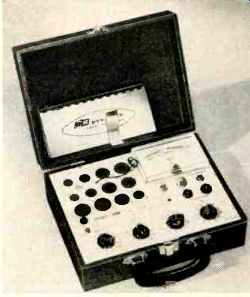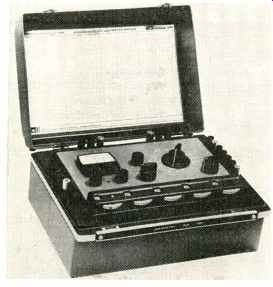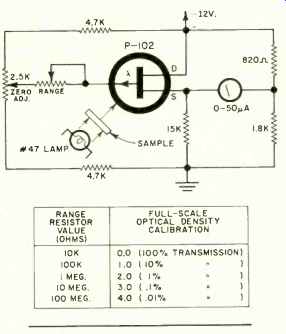(source: Electronics World, Mar. 1966)
Hewlett-Packard Model 141A Oscilloscope

THE Model 141A oscilloscope is said to be the first variable-persistence instrument; it performs scope functions that previously were impossible. The unit behaves just like its conventional counterpart until its "Persistence" or "Store" knobs are operated. Then the new Model 141A will produce gradually decaying traces whose persistence may be continuously varied from about 1/5 second to more than one minute.
When switched to the "Store" mode, the unit becomes a storage scope, yet it retains the advantages of conventional scopes: dark background for contrast, long tube life, and non-glare internal graticule screen with no-parallax display.
Waveforms may be observed up to one hour without degradation and stored for days with the instrument turned off.
The unit is actually an oscilloscope main-frame, and it accepts all plug-ins previously offered by H-P for its Model 140A, including its 20-mc. amplifiers, high-sensitivity guarded amplifiers, time-domain reflectometer, and swept-frequency indicator.
With continuous variability of trace fade-time, slowly swept traces may be continuously on display by adjusting persistence to match sweep time. Annoying flicker is removed from slow sweeps; the trend of changing waveforms can be followed by superimposing successive traces with rate-of-fade adjusted to pre vent confusion from the accumulation of too many traces; meaningless random deviations from sweep to sweep may be rejected, since successive repetitive traces will add in brightness.
Many biological phenomena occur at low rates; observing them with the variable-persistence screen, the traces may be made to linger long enough so that the entire wave is constantly on the screen, set to fade fast enough so that successive traces are not confused with their predecessors. Continuous swept-frequency displays may be made slowly for maximum resolution, with adequate visibility at all times. Successive sweeps may be superimposed to observe trends in the behavior of the subject through a series of adjustments.
The heart of the instrument is a newly designed CRT with pulsed persistence-controlling circuitry. Storage is on a storage mesh, not on the screen, so the phosphor was selected for optimum visibility, and an internal graticule was employed.
The pattern is etched on the dielectric storage mesh by secondary emission as the writing electron beam dislodges electrons from it (see diagram). Flood guns now spray low-velocity electrons toward the screen. Near the stored positive charge on the storage mesh, the screen's positive field pulls flood electrons through the mesh. These stroke the phosphor, producing the visible trace. The background remains dark.
To erase the pattern on the mesh, its static voltage is reduced all over. If the erase voltage is pulsed in successive small increments, the pattern will slowly fade. Erasure may be accelerated by widening the pulses. Variable persistence, then, is achieved by the pulse-width control on the erase pulse genera tor. Storage is accomplished by holding off the erase voltage.
The new instrument is priced at $1275 without plug-ins.
-----------------------
B&K Model 606 Tube Tester

THE Model 606 "Dyna-Jet" tube tester has been designed for fast testing of the newest color, Compactron, and other receiving tubes. It tests for shorts, grid emission (in a unique 100 megohm-sensitive circuit), leakage, gas, and cathode emission under simulated load conditions.
The sensitive grid-emission and gas-test circuit is shown here. The tube under test has its normal plate-to-grid voltage applied, but the grid is biased beyond cut-off so that no plate current flows.
This bias is applied through the 5.6-meg resistor. The same resistor is also in the grid circuit of the triode section of a 6BN8 d.c. amplifier. This tube is also biased just beyond cut-oft. Under these conditions, no plate current flows and no reading is obtained on the meter in the plate circuit.
However, if the tube under test is gaseous, or if its grid is contaminated with some of the cathode coating, then cur rent will flow from grid to plate and through the 5.6-meg. resistor back to the grid again. This will result in a voltage drop across the resistor as shown in the diagram, lifting the cut-off bias on the 6BN8 and producing a meter deflection.
Upon seeing this deflection, which reveals as little as 2 to 3 microamperes of grid current, the technician immediately knows that the tube under test is defective and should be replaced.
The tube tester is housed in a sturdy, leatherette-covered carrying case that is small enough to fit into a tube caddy. A reference index supplied with the unit contains a complete tube listing. The tester is priced at $79.95.
------------------------
Electro Scientific Model 300 Voltmeter Bridge

THIS new Model 300 potentiometer voltmeter bridge provides a complete five-dial d.c. measurement facility in one convenient battery-operated portable package. It combines the functions of a potentiometer voltmeter, a picoammeter, a wide-range guarded Wheatstone bridge, a four-terminal Kelvin bridge, a resistance comparison bridge, a ratiometer, and a high-sensitivity electronic null detector in a single instrument.
Applications include potentiometric temperature measurement with base- or noble-metal thermocouples, calibration of potentiometric indicating recorder controllers, d.c. voltmeters and ammeters, x-y recorders, analog computing elements involving linear or non-linear d.c. voltage functions, checking of d.c. power supplies, measurement of Redox and other chemically generated potentials, and calibration of resistance thermometers and thermocouples. Accurate four-terminal measurements of the low resistance of switch contacts, wires, rods, carbon brushes, windings of motors, generators, transformers, and other electrical conductors can be made.
A modulator-type detector with an integral high-gain solid-state amplifier provides better than 5-mv. d.c. sensitivity with an input impedance of one meg.
Battery life is over one year of forty hours per week use with "D"-size cells.
Five voltage ranges ( from 50 mv. full scale to 500 volts), eight current ranges ( from 0.5 ma. full-scale to 5 amp.), and ten resistance ranges ( 0.5 ohm full-scale to 500 meg.) are provided. Accuracy is ± 0.02% of reading or one switch step for essentially all functions.
The instrument is priced at $750.
------------------
FIELD-EFFECT LIGHT METER
THE photosensitive field-effect transistor is a special unipolar field effect device that receives illumination through a lens in the top of its header can.
Incident radiant energy within the wavelength band of 1.1 to 0.4 microns (near infrared to blue) will generate a current across the gate channel junction of the device. This photodiode action is amplified by the internal equivalent of a high-impedance, low-noise amplifier.
The photometer shown in the diagram uses a Siliconix P-102 device and can he used to measure optical density changes in a sample with a minimum full-scale reading of 4.0 (.01% transmission). The voltage developed across die "Range" resistor is applied to the micro-ammeter by source follower action.


